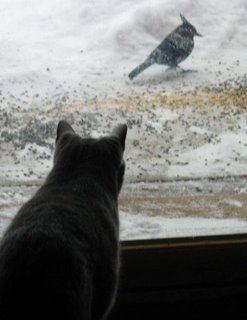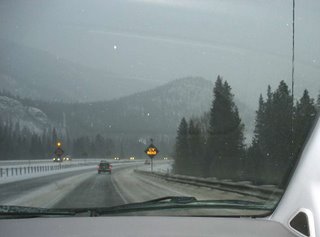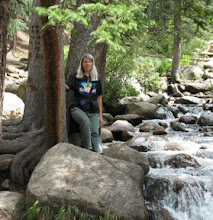But a trip to Kittredge isn't unusual. Something happened to shake, just a bit, my confidence in the odds. Our most recent snow, on Sunday, had brought another 6 to 8 inches to add to our growing piles. But yesterday, Monday even, everything started to melt. The piles are gradually slumping and, if warm temperatures prevail, will dwindle.
What does that mean for a drive in the canyon?
 Bear Creek runs roughly west to east, with lots of twists and turns. At the mouth of the Bear, the canyon is especially steep and narrow. Its north-facing slopes (photo) remained bound in snow, but its south-facing rock walls were warm and dripping, as snow and ice were hit by the sun for just a few hours of the day. In fact, returning just an hour later, at 2:30 p.m., those warm walls were already feeling the lengthening chill of premature sunset.
Bear Creek runs roughly west to east, with lots of twists and turns. At the mouth of the Bear, the canyon is especially steep and narrow. Its north-facing slopes (photo) remained bound in snow, but its south-facing rock walls were warm and dripping, as snow and ice were hit by the sun for just a few hours of the day. In fact, returning just an hour later, at 2:30 p.m., those warm walls were already feeling the lengthening chill of premature sunset.Above, my peripheral vision caught a falling object, a rock loosened by the thawing of its resident cliff face. It landed in the road ahead of me. There wasn't even time to swerve, only to register that it was flat enough to drive over. Apparently, my number was not yet up!
After that, rather more alert, I began to notice the number of new rocks on and along the road. It crossed my mind it might not be the best day for a canyon drive, with temps in the 40s after a cold night. I went on, reminding myself that hundreds, maybe thousands, drive this canyon daily without mishap. Is there really strength, or just reassurance, in numbers?
Witnessing geology in action gives you pause. Sure, the road is lined with "Falling Rocks" signs, but how many of us notice them? And what are you supposed to do with that warning? Falling rocks are not rare, just unpredictable. Yesterday, geology was acting mostly on smallish rocks, less than a foot in diameter, but surely geology has proven capable of much more, even recently right here on the Front Range.
Somehow, it's comforting to know that you'll never see the one that hits you!

















